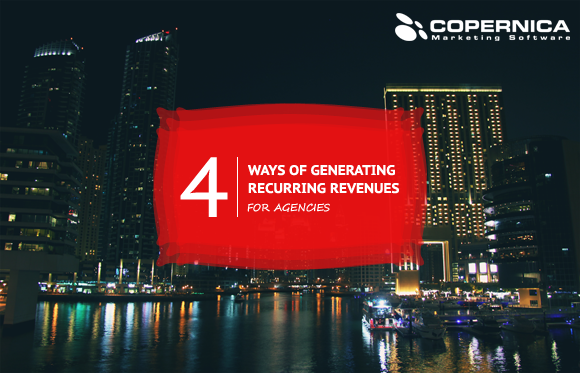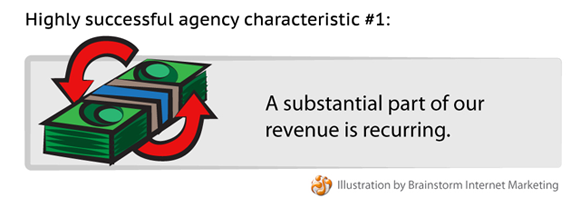Four ways of generating recurring revenues as an agency
This article is part of a series of articles about the 5 characteristics of highly successful agencies.
Stable and recurring revenues lead to a healthy long-term oriented operation (and happy shareholders). Agencies, however, have not always focused on recurring revenues, simply because they didn't need to. In the past, full-service agencies could survive (to say the least) on a handful of customers. If services would be delivered adequately, the agency would have the promise of a healthy revenue for years to come, because:
- Client budgets were known upfront
- Exact amount of work involved was not made transparent to the client
- Profit margins were phenomenal
- Agencies would have long term contracts firmly in place with the brand
Times have changed, in this article we discuss developments that have impacted turnover growth for agencies and four ways to generate recurring revenues for agencies.

More agencies for one brand
Agency turnover has suffered from major impact by the fact that that brand no longer works with only one agency anymore. Often, there are agencies appointed for different aspects of marketing. Most agencies try to move to the front of the process to discuss 'strategy' in the board room.
LAW Creative, a leading European agency specialising in hospitality and leisure, has seen this development coming years ago. Brett Sammels, CSD for LAW Creative: "If there is such a thing like a silver bullet when it comes to communications, you really have to wrap the strategic and creative thinking with the data and technology. We are no longer living in a world where great creative is the be all and end all. Nowadays, post-recession, it's all about return on investment".
Long term contracts are a fad of the past. Dependency on only a handful of clients, continuously competing with other agencies, and the lack of long term contracts are the outlook of the traditional agency. For agencies, losing an A-client can lead to
- a dramatic decrease in turnover
- letting go of staff and possibly
- bankruptcy
The sales challenge for agencies
Traditionally, new business development has been one of the biggest challenges for agencies. The revenue growth for most project-oriented agencies resembles a wave instead of an upward curve. Logically, the best marketers and strategists are not free for business development when they are billable for a client. This reduces the time that they can spend on sales and marketing for the agency itself to nearly zero. So only when a project is completed, and no new project is waiting, there is time for business development, hence, the wave-like upward curve.
When the sales pipeline is not continuously filled, this creates a wave-like curve for the turnover.
The technological challenge
Marketing has never been as paradoxical as today. On the one hand, all current marketing technology offer a marketer the potential of taking control of all marketing, but on the other hand, there are so many tools, apps, technologies, whitepapers and guru's, that finding a starting point, making the right selection and keeping track of all developments has become nearly impossible.
Pablo Jonas, chief operating officer of Brussels based agency Opus adds: "In a very small amount of time, marketing has made a complete shift. Nowadays, marketing revolves around analytics, big data, algorithms, mathematics, programmatic media buying, real-time bidding, search optimisation and testing. Yes, everything traditional advertising and communications folk detest."
The modern agency needs to create a new type of person, the digital native with social skills.
Overcoming the risks of fluctuating results
When most of your revenues come from projects only, predicting long-term revenues is difficult. This makes investing in the business risky and thus it impacts the long term value of your agency.
Agencies can overcome the risks of revenues from projects only by developing more business from recurring revenues. As Brett Sammels from Law Creative adds: "New technologies have been able to offer us the opportunity to go back out to our existing clients, and give them other great services that we can offer. Also, it allows us to approach new clients with the great case studies that we built up with our existing clients."
Four ways of generating recurring revenues

Some examples of recurring revenues for agencies are:
1 Revenues from licenses
Strangely enough, a successful agency receives a substantial turnover from third-party solutions like hosting and software. The revenue potential of offering software is massive, because as an agency you don't have the software development costs. Typically, revenues increase exponentially when number of accounts (and variables if applicable) increase in volume.
Besides exponential growth of turnover as you grow, another benefit of recurring revenues from licenses is the scalability of this revenue stream.
2 Revenue-sharing
If you believe in your capacities as an agency and you can get all requirements aligned, you could consider a revenue-based model instead of a consultancy-based model. The difference between the two is that a revenue-based model brings turnover only if certain results are achieved. Very important in a model like this is that you:
- Control all parts of the business that might affect the results
- Believe in the brand's proposition
Examples of revenue-sharing can be ad campaigns (number of leads for example), e-commerce projects (for example turnover) and marketing automation campaigns (number of sales qualified leads for instance).
Although this revenue stream is not as scalable as revenues from licenses, if your results are good, turnover from revenue-sharing based models can be extremely rewarding.
3 Subscription services
Developing subscription services to generate a stable stream of work and turnover provide stability. You could offer clients who buy a number of consultancy hours or deliverables (like an x amount of newsletters per month, an x number of blog posts) a fixed monthly fee. Content marketing and marketing automation lend themselves perfectly for subscription-based services.
4 Commission
Traditionally, media buying has always been a very profitable business for agencies. Commission for agencies can come from media buying, but also by referring business to third parties like software vendors, hosting providers or other service providers.
Which other forms of developing stable revenues can you add? How has your agency secured recurring revenues?
You might also like the following articles:
Copernica partner support
Ways of generating recurring revenues with Copernica
Copernica TV: All Recordings

















